Local News
Construction of new home of Chesed Shel Emes complete – on time and on budget!
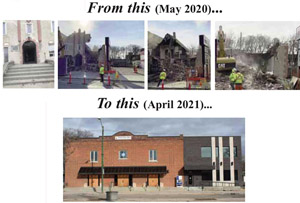 By BERNIE BELLAN It was just over a little over two years ago that the Chesed Shel Emes (the Winnipeg Jewish community’s burial society) launched a capital campaign, with the intent to build “a new facility to meet the needs of the Jewish community for many years to come,” an announcement in the May 10, 2019 issue of this paper said.
By BERNIE BELLAN It was just over a little over two years ago that the Chesed Shel Emes (the Winnipeg Jewish community’s burial society) launched a capital campaign, with the intent to build “a new facility to meet the needs of the Jewish community for many years to come,” an announcement in the May 10, 2019 issue of this paper said.
That announcement went on to say that the “Chesed Shel Emes’s south building is 114-years-old. It was built in 1905 as a private residence, and was purchased by the newly established Chesed Shel Emes in 1930. The building has met the needs of thousands of families over the years, and is showing its age. The attached chapel, built in 1947, is in good repair and will be a beautiful complement to the new building.
“The new building will provide a better and more comfortable experience for mourners and other visitors,” said Rena Boroditsky, Executive Director of the Chesed Shel Emes. “And for our volunteers, we are designing this new space with safety top of mind.”
“Having an effective and dignified infrastructure to prepare the deceased for burial and to support mourners is something a strong community does for itself.
“The funds raised will be used to: demolish the existing south building; build the new structure; protect the north building during demolition and construction; and furnish the new building with new equipment. The vision is of a building that is handsome, durable, and comforting and that includes state-of-the-art equipment for the care of the deceased. “The new 4,000-square-foot building will include the following features:
“A new, larger tahara room with stainless steel counters and more room for volunteers to perform their work safely (“tahara” is the ritual washing and dressing of a Jewish person in preparation for burial);
“new, state-of-the-art refrigeration units;
“new mechanical lifts for transferring bodies more safely;
“enhanced safety features to improve the experience of volunteers and ensure the dignity of the deceased;
“expanded storage space for caskets, shrouds, and supplies;
“an elevator for guests and volunteers with mobility issues;
“wheelchair access to the building;
“private meeting spaces for mourners, extended family, and friends to gather (currently, mourners use the boardroom);
“more comfortable accommodations for shomrim (“shomrim” are guards who watch over the deceased, so that they are never alone); (When I met with Rena on April 8 this year she added that now that there is quite a comfortable room for “shomrim” to guard over the deceased, she is hoping that family members themselves will partake of the mitzvah of serving as “shomrimr” for the deceased.)
“a safer, more accessible back staircase and entrance way;
“enhanced washroom facilities;
“refurbished office space;
“refurbished basement crawl space for additional storage (the current basement is undeveloped);
“state-of-the-art heating and cooling systems; and other features to create better conditions for mourners, staff, and volunteers, and to ensure the dignity of the deceased.”
Now, in less than one year, the new building is finished – on time and on budget.
According to Rena Boroditsky, the capital campaign, which was under the direction of the Jewish Federation’s former CEO, Bob Freedman, ended up raising $3.25 million.
In our May 13, 2020 issue we noted that, as of that date, there had been 400 individual donors who had contributed a total of $2.8 million. Bob Freedman said at the time: “The capital campaign has raised $2.8 million – that’s pretty darn good. Remember, in a capital campaign we give donors several years to pay off their pledges. In some cases we give three-five years – if it’s a larger pledge. Cash wise we’re doing pretty well. One of the reasons we’re starting (work on the demolition of the old house and eventually construction) is we have money to pay the contractor going forward – so it’s not just pledges. Close to half the pledges have already been redeemed.”
Fast forward to April 8, 2021 and, in a conversation with Rena Boroditsky, she told me that in the end there were 800 donors to the capital campaign. As well, the City of Winnipeg contributed $25,000 toward the construction of an elevator in the new building.
As Rena said, “For us to make a plan, raise the money and build it on time is quite an accomplishment.” (What is even more remarkable is that the City of Winnipeg has actually already given the Chesed an occupancy permit! For anyone who has dealt with the city on occupancy permits, that in itself is a minor miracle!)
Rena paid special tribute to Akman Construction for the speed and efficiency with which both the demolition of the old house that had served as the prior home of the Chesed was demolished and the construction of the new building was accomplished.
“We still have to buy some furniture,“ Rena noted, but the move back into the new home of the Chesed from what had been a temporary relocation to Chapel Lawn Funeral Home is proceeding rapidly. (Rena showed me her desk, which is situated for the time being in the middle of the floor in the Chesed chape, saying that she can hardly wait to move into her new office.)
As I toured the new building with Rena, she proudly showed me all the enhancements that will make the new Chesed something about which the entire community can be proud. Most notable perhaps is the additions of three – count ‘em, three washrooms! (No more waiting around to use a washroom before driving out to one of the cemeteries.)
Then, in one room that we entered, Rena said: “Here’s a surprise” – and she opened a special compartment housing the old safe that is a relic going back almost 100 years.
When I spoke with Bob Freedman last May, he explained what the safe is all about:
Bob: “Bernie, have you seen the safe? It must weigh 500 pounds.”
“So, what’s in the safe?” I asked.
“Not cash, unfortunately. When I first opened the doors, I opened a bunch of little books. People who passed away were recorded – by pencil or pen, by name – their Hebrew name, the date they died. So I looked up my mum, I looked up my dad. It’s really a history of the Jewish community. There was a big picture of the machers from the 1930s – all men, of course. There was a big picture of the ladies’ auxiliary – all looking very stern.
Bob added this observation: “By the way, if those men knew that the place was being run by a woman, they’d all be spinning in their graves.
“When you ask someone how do you define a Jewish community, as opposed to a community with Jews living in it, there are three things: A shul, a school, and a chevra kadisha – a burial society.
“Burial is one of the first things people thought about when they came from the old country. They looked for a place to bury people.”
Once the Chesed is fully functioning, Rena told me on April 8, it can be expected to handle between 115-140 deceased in a year. Last year was an especially bad one for deaths in our community, with 140 deaths recorded to the end of November – which is the end of the Chesed’s fiscal year, Rena noted. December – February was an even more brutal period for the number of Jewish deaths, she observed, with 68 deaths in those three months alone. (That number seems to have finally tapered off, thank God.)
And, while the Chesed serves as the home for Winnipeg’s Jewish community’s burial society (except for Temple Shalom’s own “chevra kadisha”, known as “Mikdash Shalom”, which is located at Chapel Lawn Funeral Home), very few funeral services actually take place in the Chesed chapel itself.
“Typically, we’ve only had about 30 funeral services a year held in the chapel here,” Rena noted. “But now that we have the new building, with a handicap ramp for the first time and three washrooms, once pallbearers are allowed to come back and funerals can once again allow guests to attend, we expect that there will be more funerals held at the Chesed itself,” Rena said.
She added that, as more and more members of the community remain unaffiliated with a synagogue, Rena anticipates an even greater use of the Chesed Shel Emes.
Local News
Gustavo Zentner talks about his role as CIJA Vice-President for Manitoba and Saskatchewan

By BERNIE BELLAN Gustavo Zentner has played many roles since arriving in Winnipeg from his native Argentina in the early 1990s.
In a May 2022 article written for The Jewish Post & News by Myron Love, Myron wrote this about Zentner, who had just become President of the Jewish Federation of Winnipeg at the time:
“The new president of the Jewish Federation of Winnipeg – who originally hails from the city of Corrientes in northeastern Argentina – notes that his great-grandfather –among the earliest Jewish immigrants to the city, was one of the founding members of the organized Jewish community and its cemetery – and his mother was the first (and thus far still the only) female to lead the community.
“ ‘My earliest memories are of my mother always chairing meetings of the Federation,’ he recalls.
Thus, it is no surprise that Zentner threw himself into volunteering with the Jewish Federation of Winnipeg very soon after he arrived in our community – among the wave of Jews from Argentina who immigrated here 20-25 years ago.
“ ‘I was delighted to come to Winnipeg,’ the new Federation president says. ‘I found a warm and welcoming community and was happy to contribute in any way I could.’ Zentner adds, ‘This is a wonderful community and I believe that everyone counts, every person has a story to tell and something to contribute, let’s make sure everyone is part of the conversation’.
“As a board member, Zentner has, over the past 15 years, chaired first the Human Resources Committee – followed by the Community Planning, Allocations Committee, and most recently served as Treasurer, chairing the Finance and Audit Committees. He has volunteered with many other organizations; no doubt that experience will serve him well as he builds bridges throughout the community.
“In his business career Zentner is the president of InterPOC (International Point of Commerce), an international business consultant, and Honorary Consul of Brazil in Manitoba. Zentner places a lot of emphasis on consultation and planning.”
It was during his term as President of the Federation, in the immediate aftermath of the October 7, 2023 Hamas massacre, that Zentner played a pivotal role in rallying, not only members of the Jewish community, but members of the larger Winnipeg community, in support of Israel.
Zentner chaired three large rallies that year – the first at the Asper Campus in October , when over 2,000 individuals crowded outdoors on the campus lawn , followed by another large rally at the Manitoba Legislature, and finally a rally in the Rady JCC gym in memory of the late Vivian Silver.
Each time Zentner touched just the right chord, demonstrating an eloquence along wth a sincere passion for Israel and the Jewish community here. In 2024 Zentner developed strong lines of communication with various levels of government to bring awareness of the heightened antisemitism that had sprung up everywhere in the wake of the October 7 attack. Zentner was especially successful in forming a strong bond with then-Winnipeg Police Service Chief Danny Smyth, along with other members of the WPS, in an effort to respond to and, where possible, prevent antisemitic attacks in the city.
Thus, it was no surprise that, not too long after Zentner’s completion of his term as Federation President, he moved into a new position, this time as the Centre for Israel and Jewish Affairs Vice-President for Manitoba and Saskatchewan.
This past September 25th, Zentner spoke at the Remis Forum Luncheon, where he told the audience about his role with CIJA.
Zentner began by describing his own firsthand experience witnessing terrorism as a young Argentinean Jew during the 1990s: “I was there when there were two terrorist attacks – in March 17, 1992 and July 18, 1994. That forged my Jewish identity and my commitment to becoming more visible in terms of leadership in the Jewish community, while building a business or working for others or working for government.”
While Zentner spent a great deal of time during his talk focusing on the need for Winnipeg Jews to support Israel and especially to engage the younger generations in supporting Israel, he also took time to explain just what it is that CIJA does and what his particular role is in that organization.
“Our main business is Canadian Jewish advocacy,” he said. “CIJA is the advocacy agent of Jewish federations across the country.”
The head office of CIJA is located in Toronto, Zentner noted.. The president and CEO of CIJA, Noah Shack, took over from his longtime predecessor, Shimon Koffler Fogel, in June this year. In addition to the Winnipeg office, CIJA also has staff in Montreal, Ottawa, and Vancouver.
“Our core objective today is to combat antisemitism across Canada,” Zentner stated. But, in addition to that role, CIJA also consults with other Jewish communities around the world in a group Zentner described as the “J7” (similar to the G7 group of countries that discusses economic issues).
“Canada’s is one of the seven largest Jewish communities in the world,” he noted. (In order, the world’s seven largest Jewish communities are in: Israel, the US, France, Canada, the United KIngdom, Russia, and Argentina.)
As Zentner explained, “So, when we know that the Prime Minister in Australia or the Prime Minister of Great Britain is thinking of something, and our counterparts in those countries are considering what the reaction will be, we are (engaging) in a lot of discussion so we can anticipate and respond, (not only to) support another Jewish community in another country, but also (to) understand what may be the implications of such policies here.”
In addition, Zentner noted, CIJA is also the representative organization which handles compensation for Holocaust survivors through the Claims Conference.
When it comes to combatting antisemitism, however, Zentner stressed that his “background in economic diplomacy” has been instrumental in affecting how he “engages with governments.”
As CIJA’s representative here, Zentner said that his approach to dealing with various levels of government “is different than many other Jewish organizations. And I can guarantee you it’s mostly different than what most Jews in Winnipeg expect of me because I used to speak in a different way. Today I have to go to meetings with the chief of police or the chairman of the Winnipeg police board, and around the table there are many other minority groups. And while they each focus on their own activities, sometimes what people say is not reflecting on reality. So that’s a very diplomatic way of saying, ‘What are you talking about?… My community, the Jewish community has been intimidated since last Yom Kippur (2023).”
Zentner added that he has been very direct in telling various levels of government, especially the police “to take action” to combat antisemitism.
“To do that, we consult with and engage with law enforcement on an ongoing basis,” he said. And, when it comes to defending Jewish members of the community, Zentner emphasized that we should be looking to the police to do that job – not to members of our own community: “We look to law enforcement to do that for us,” he stressed.
But, by asking governments to be proactive in defending members of the Jewish community, Zentner explained, ..We’re not telling “civil society government to defend the Jews,” he said. “No, we’re saying ‘defend Canadian values’.”
A second objective for him though, Zentner suggested, is to revitalize “partnerships” with Israel so that governments can have “positive, healthy relationships with Israel…In my organization, and in my job, I am in charge of ensuring that we have viable, credible, open lines of meaningful engagement and communication with levels of government. And that is not easy.”
A “third component” of his role as CIJA representative, he said, is “community mobilization,” educating members of the Jewish community “on the importance of all of us remaining not only vigilant, but active.”
“Moving on,” Zentner said, he wanted to talk about CIJA’s “advocacy” work – “advocating for Jewish life, protecting synagogues, our community centres, and our schools – changing the course of policy…” through such measures as “Bill C9,” the Federal Government’s recently passed law banning “hate crimes” as defined in the statute.
Zentner went on to discuss the Federal Government’s recent decision to recognize a Palestinian state, and criticized that announcement, saying that “recognition cannot be without expectation of clear conditions for that Palestinian statehood.”
CIJA had been communicating with Prime Minister Carney since he first signalled this past July that Canada would be recognizing a Palestinian state in September, Zentner said, wanting to make sure that what the government said it would do was not going to be a unilateral preemptive gift reward to Hamas.” Again, he emphasized that what CIJA was trying to do was impress upon the government that it was not advocating for Israel – or even for the Jewish community alone, it was advocating for upholding “Canadian values.”
Another element of CIJA’s work, Zentner said, is “providing anti-Semitism training and Holocaust education. We provide support to other organizations that are training…. I’m working with the provincial government, the civil service commission, to ensure that they have anti-racism policies in place that there is (sic.) curricula to address antisemitism and anti-Zionism.”
Zentner went on to field a number of questions from the audience, touching upon consultations in which he’s been involved with the police – especially around the time that Folklorama was happening and there were regular protests from pro-Palestinians outside the Asper Campus. Those discussions led to an agreement that “Basically, to make sure that there is, whether through permits or other activities for next year, not to have protesters or pro-Hamas protesters outside the campus, the way they have been doing the tradition for the last ten years.”
He added that the Winnipeg Police Service is “committed to making sure they (will) have a strong presence and that they will act more effectively than what they” did this year.
At the end of his talk, Zentner harkened back to reminding the audience that he and his family left Argentina following two terrorist attacks against Jews (in 1992 and 1994).
He said, “We must not go into a dark space. That’s my role every day. And it’s a difficult role. But I’m not going to let that define who I am or how we define our community. I fully support and need to make sure that we all support our relationship between our community, Canada and Israel… I understand that there is more to (being) Jewish and identity than being Israeli and serving in the army,” but we have to be “moving forward. We have not lost anything. These are difficult times and I know it’s easy to feel lost, but we are not.”
Local News
New play structure – “Gan Reut” (Friendship Garden) opens at Asper Campus
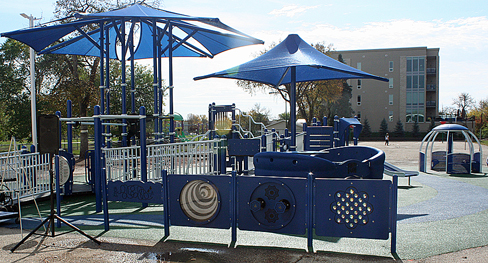
By BERNIE BELLAN It was a gorgeous Friday afternoon, October 3, when Lori Binder, Gray Academy Head of School (also Board of Jewish Education CEO) welcomed about 40 individuals to the opening of a brand new play structure on the Asper Campus – situated exactly where the old play structure (which had opened in 1997 with the opening of the campus) had been.
Most of the individuals who were there that day had played a role helping to see the new play structure built – either as donors, or as members of organizations that had participated in the planning and construction of the new play structure.
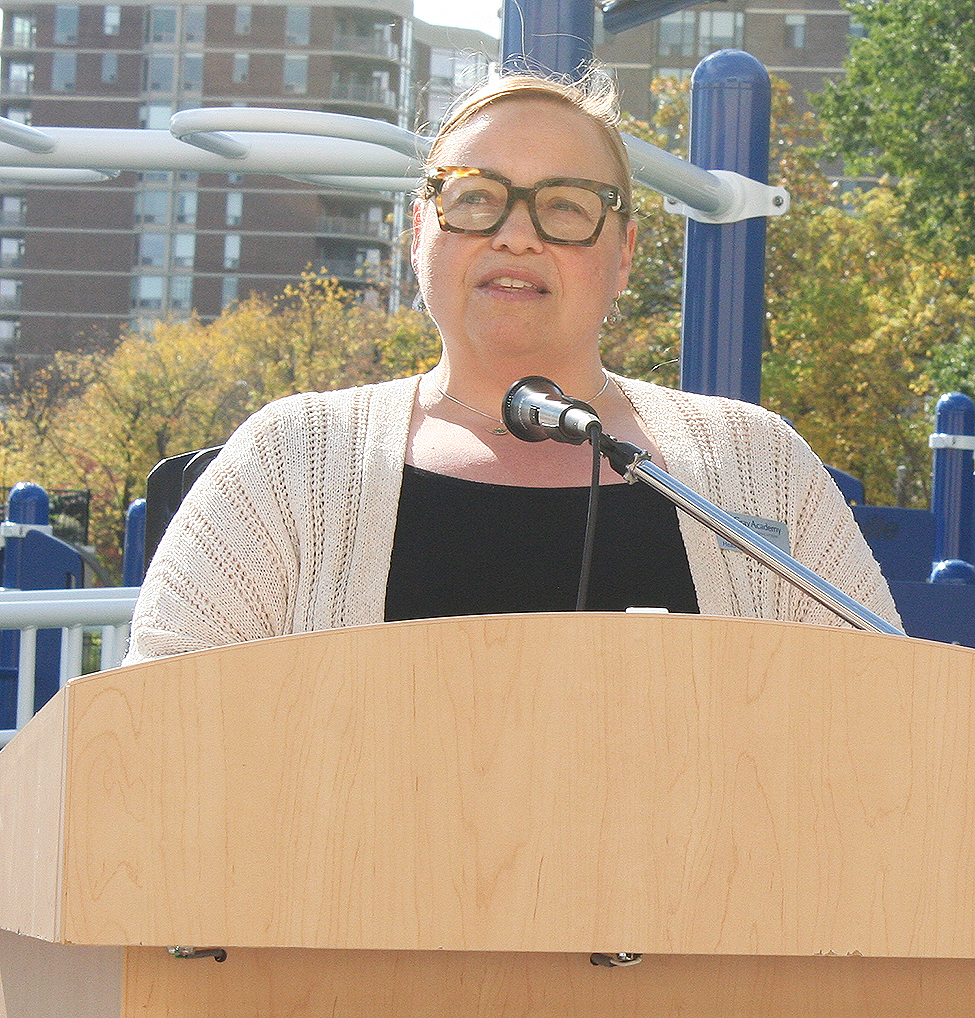
As Binder explained, “We wanted to call this the Friendship Garden. We wanted it to have a Hebrew name. ‘Reut’ – play, is the language of friendship and it’s also the language of learning. And so today for the very first time, as our kids were watching the structure be built – and that too was also an amazing learning tool, they began to learn to use the structure.”
Why was there a need for a new playground, some might wonder – when the old one was only 28 years old?
Binder cited several reasons for wanting a new play structure: “A lot of injuries were happening because there was pea gravel, and the pea gravel was surrounded by a border of wood. And if you did not have the ability to step over or walk through the pea gravel, you could potentially have an injury.”
She added that “pea gravel is only used in 3% of playgrounds today because you might skid and need a bandaid or have a cut.”
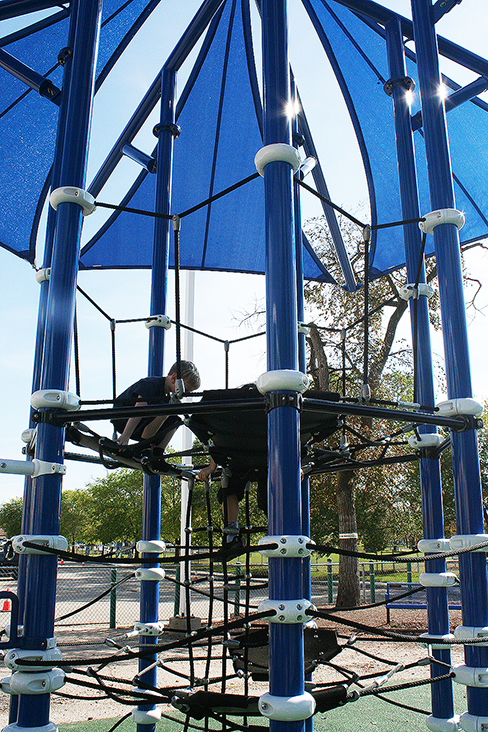
“But we also recognized that with the broken structure and the inability for all children in our community to play we wanted to begin to envision a new structure,” Binder added.
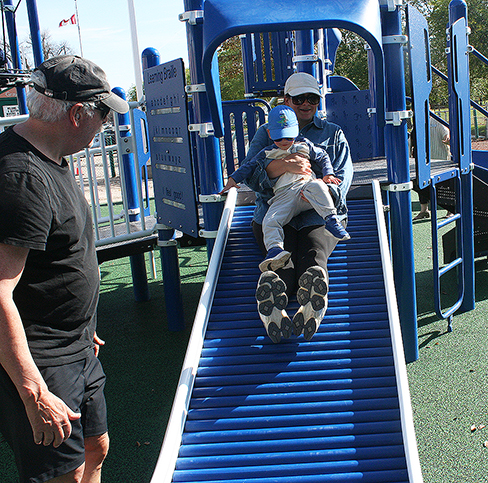
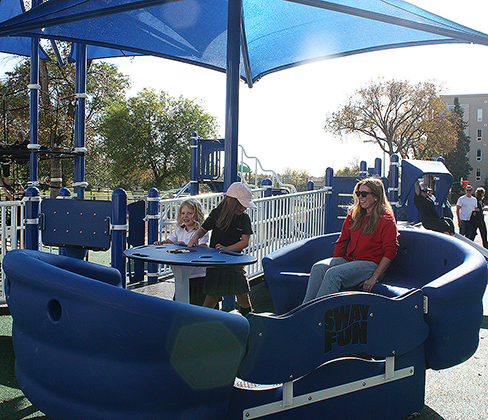
The actual project took shape in a relatively short period of time. Design and construction was handled by a company known as Playgrounds R Us. President of the company, Matt Lacroix, noted that “typically a playground of not even this size” would take much longer to plan and build.
“We typically work with schools probably three to five years, sometimes two. So, from start to finish, for us to start a year and a half ago to now is pretty phenomenal,” Lacroix observed.
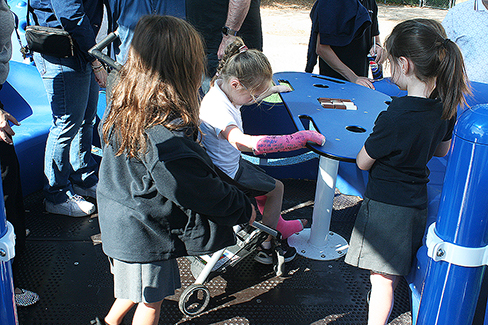
There are many new innovations included in Gan Reut, including the resilient rubber foundation, the handicap accessible play structures (that can even accommodate children in wheelchairs) and, on an unexpectedly hot October day – something that proved to be most welcome: shade everywhere you went.
Getting the project done required cooperation among Gray Academy, the Rady JCC, and the Asper Campus. When Binder first approached the Jewish Foundation for funding assistance, however, she said that initially, “we got denied.” However, rather than that being an impediment to moving forward, Binder said “it turned out to be a blessing.”
The reason, she explained, is the Jewish Foundation “plays such an integral role in matching us with potential donors, helping us bring something to light or getting something started.”
In the case of the playground project, it was the Rich family, led by Gavin Rich, who stepped up as lead donors. There were many other donors as well. (You can see all the donors’ names in the accompanying photo.) Also, the Jewish Foundation did come through with a grant – for the rubber foundation.
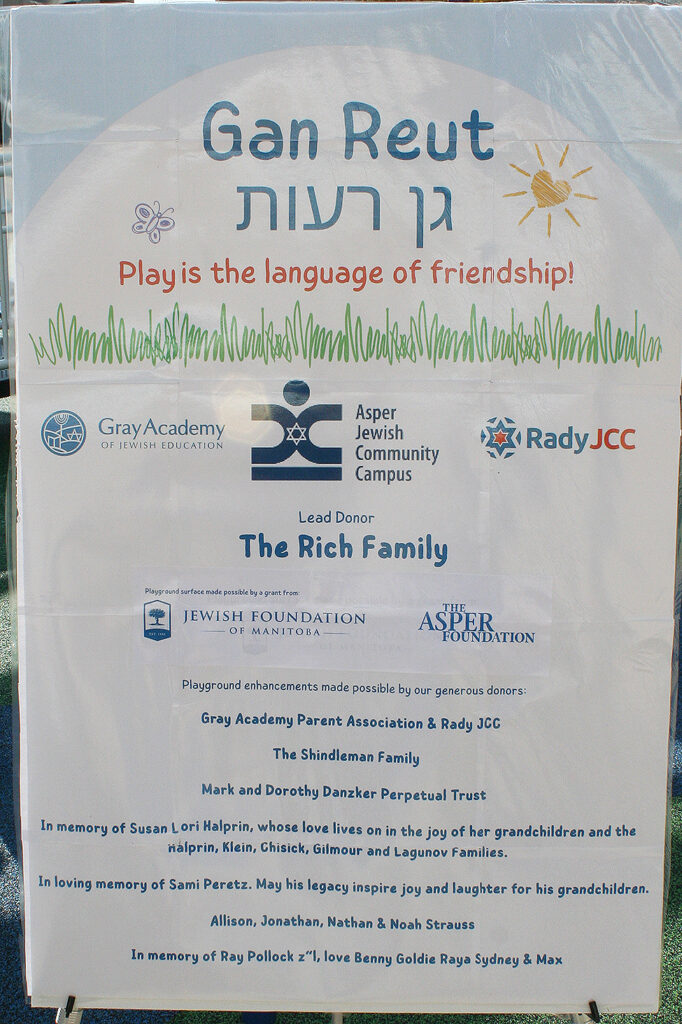
Binder spoke of the important role that play serves in children’s development: “Diane Ackerman states that play is the brain’s favourite way of learning. And if you go into the daycare or into any of our early childhood classrooms, you will see that they learn through play. Dr. Stewart Brown notes that nothing lights up a child’s brain-like play. And I bet some of you will want to also play because even at as adults, we like to play.”
The blue and white colour of the playground was also a deliberate choice, Binder noted. “Blue and white,” she suggested, was “very purposely chosen to match the colour of the Israeli flag and give us a reminder every day of coming to this amazing Jewish community campus.”
When it came to planning what would go into the playground, Binder thanked Rob Berkowits from the Rady JCC and Curtis Martin from the Asper Jewish Community Campus, “who were along for the journey…We also have many of our educators, an occupational therapist, early childhood specialists, elementary specialists, student life coordinators, all coming together with all of the different ideas.”
“I have to say it is overwhelming,” Binder added. “I’ve not really been involved in such a renovation project; it’s hard to make decisions. You can have a million different kinds of playgrounds.”
Not only will the playground, however, serve as a major enhancement to be enjoyed by students at Gray Academy and the Rady JCC daycare during weekdays, it will be open to everyone in the community 24/7, Binder noted.
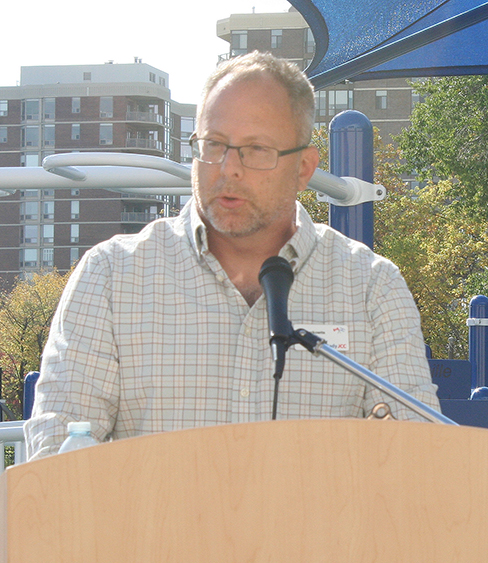
Following Binder’s remarks, attendees heard from Rob Berkowits, CEO of the Rady JCC, who acknowledged the key role Binder had played in bringing the project to fruition: “I want to extend a heartfelt thanks to Lori Binder, Head of School at Gray Academy, for unwavering leadership in bringing this vision to life.”
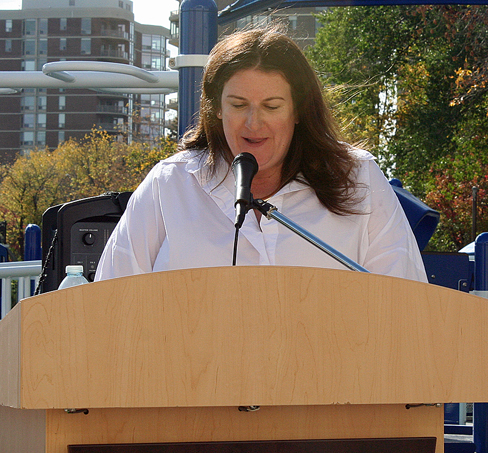
Finally, Jill Winograd, who was representing the Asper Jewish Community Campus, offered remarks: “Spaces like this are more than slides or swings. They’re about belonging, imagination, and giving kids a safe place to grow together. So this project wasn’t about starting fresh, but renewal, taking something well used.
“So what makes this playground matter isn’t just the newer equipment or the safer surfaces, but the thoughtfulness behind it. Accessible roots, quiet corners. And spaces that welcome kids, parents and grandparents together. It’s built for inclusion and community. And I think grandparents is such a key word here because it’s really so lovely to see from our sponsors how many are in memory of grandparents and how special that time is at the playground for them.”
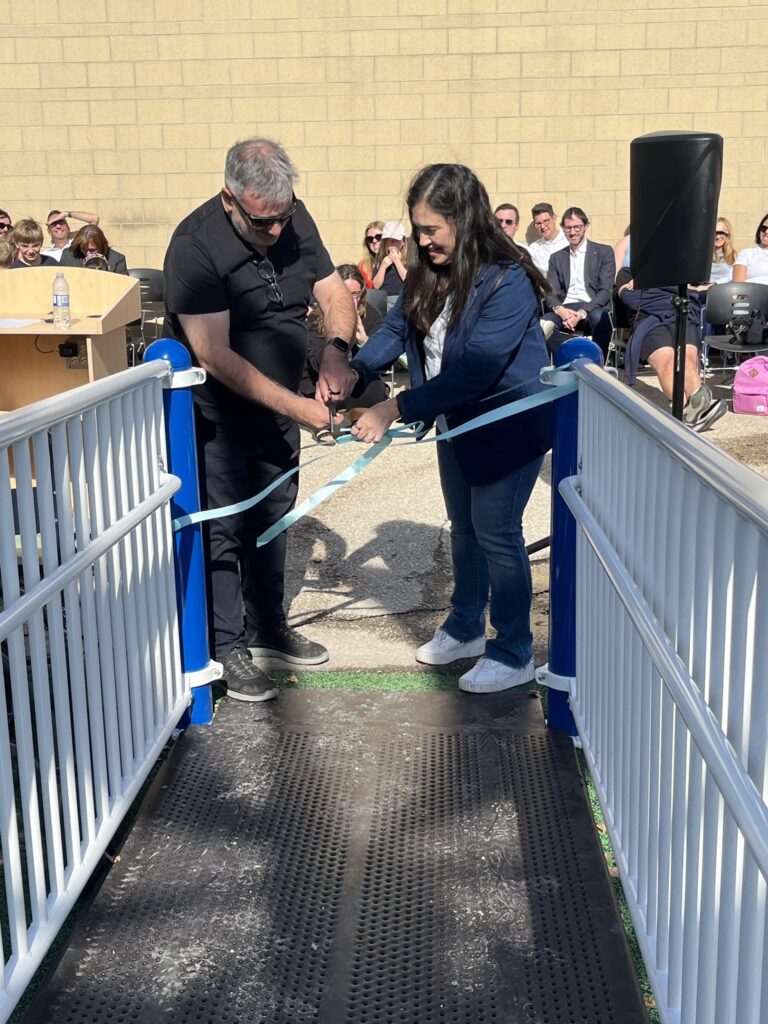
And, with that – and a ceremonial ribbon cutting by Gavin Rich and Marni Slonim, Grade 2 students from Gray Academy descended upon the structure – many with parents in tow, to demonstrate all the many features of the beautiful new playground.
Local News
Gray Academy registration numbers continuing their upward trajectory
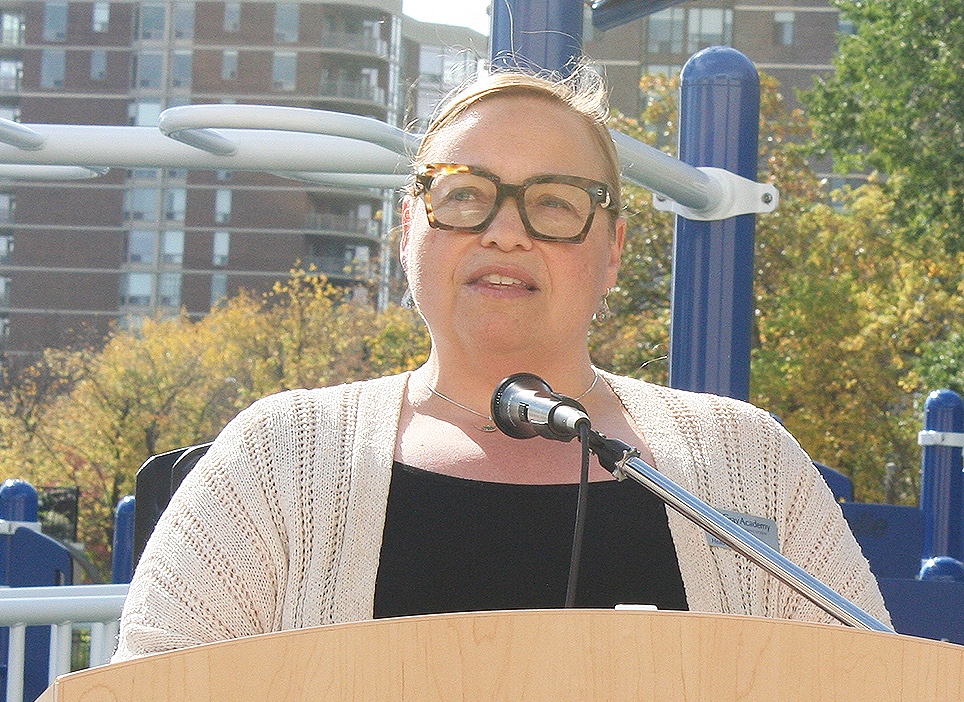
By MYRON LOVE Lori Binder, Gray Academy’s Head of School and CEO of the Winnipeg Board of Jewish Education, is happy to report that this year’s enrolment stands at 517 – the highest back-to-school number since 2013-2014. “We have had to add a second Junior Kindergarten class and, for the second consecutive year, a third kindergarten class,” she says.
Gray Academy students speak of feeling safe and being able to connect with their roots. As Binder points out, many of the students have parents and even grandparents who attended Gray Academy or its founding high school, Joseph Wolinsky Collegiate. In addition, 25% of the staff are Gray Academy alumni.
The school also plays an integral role in helping families moving to Winnipeg from Israel, Argentina, Brazil and other countries to adapt to their new homes. Over the past two years, the EAL (English as an additional language) program has expanded significantly to accommodate growing needs.
Gray Academy is one of the only JK-12 Jewish day schools in Canada. The school remains committed to academic excellence, along with programming that builds community and connection. Gray Academy was the first Jewish day school in Canada to receive accreditation from Canadian Accredited Independent Schools (CAIS), a community of independent schools that meet and exceed rigorous national standards that inspire excellence and ongoing school improvement.
New this year, Binder notes, is the just-built AJCC Gan Re’ut (Friendship Garden), a fully accessible playground that children of all ages and abilities can use and enjoy. A new rubber foundation and accessible equipment make the new playground safer and more accessible for everyone.
She further reports that the four-year-old Gray Academy-Tough Duck Community Ice Rink, located on Danzker Field, has been enhanced with an asphalt base so that the facility can be used year-round for a wider variety of activities.
The school has also expanded its after-school music programs this year. In addition to traditional band and drumline programs, students can also take part in jazz, rock and vocal ensembles.
Binder notes that parents and grandparents of children are welcome to engage with the school. “Last year we launched a new “Grandpals” program for grandparents,” she says. “We offer several different ways for grandparents or any special seniors in students’ lives to engage with the school while being able to see their grandchildren.”
And did I mention that, over the years, Gray Academy’s outstanding debating program has been placing very well in national and international competitions?
In terms of tefillah and spirituality, Binder reports that the school is building on past informal connections with local clergy to allow more student interaction with our community’s rabbis and cantors. Throughout the year, clergy from various congregations will be coming in to the school in a more formal way.
A very important part of Gray Academy’s mission is fostering a love of Israel. Over the years, quite a few Gray Academy graduates have made Aliyah.
An important part of Israel education has been the nearly 30-year-long Jewish Federation of Winnipeg P2G (Partnership 2Gether) student and teacher exchange programs linking Gray Academy high school students with their counterparts at Danciger High School in the northern Israeli community of Kiryat Shmona and Nachshonei Hachula Elementary School in Yesod Hamala in the Hula Valley. For many years, Gray Academy would send groups of six to eight Grade 10 and 11 students to visit Danciger. Likewise, Danciger would send students to visit Gray Academy.
In fact, a group of Danciger students and faculty happened to be in Winnipeg on October 7, 2023. When the group was forced unexpectedly to extend their stay in Winnipeg until flights to Israel could resume, Danciger students and staff participated in our community’s subsequent show of support for our brothers and sisters in Israel.
While the program has been paused since then, Binder reports that she was in Israel in July and visited both schools. “With many Israelis having been able to return to their homes in the north after nearly 18 months of displacement, we are hoping to restart the exchange programs in the spring,” she says.
Binder adds that two young Israelis volunteering with Shaarey Zedek Congregation in something called the “ShinShinim program” (which is a year of service in the Diaspora prior to serving in the IDF) have recently arrived in Winnipeg and will be paying weekly visits to the school. The Jewish Agency for Israel’s ShinShinim program sends Israeli Grade 12 graduates to Jewish communities in the diaspora to enhance the teaching of Hebrew and love for Israel.
To commemorate October 7, the school – for the third year in a row – will be holding “Havdallah for Hope,” a memorial program for high school students, followed by Havdalah for the entire student body and community guests.
Binder points out that the school has a strong focus on affordability. “It is very important to us that no child is turned away because a family can’t afford to pay,” she says.
She notes that Manitoba is one of only a few Canadian provinces that fund independent schools such as Gray Academy, with the school receiving approximately 50% of comparable public school funding per student. Binder adds that the school offers a robust Bursary Assistance program, strongly supported by funding from the Jewish Federation of Winnipeg’s Combined Jewish Appeal. “Over 60% of our families receive some level of bursary support,” she reports. “We work with every family to ensure that no child is ever turned away because of inability to cover the full parental contribution.”
Just weeks into the new school year, Gray Academy is already looking ahead to enrolment for next September.
For more information about what Gray Academy has to offer and application dates, phone 204 477-7425 or email admissions@grayacademy.ca.


